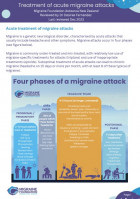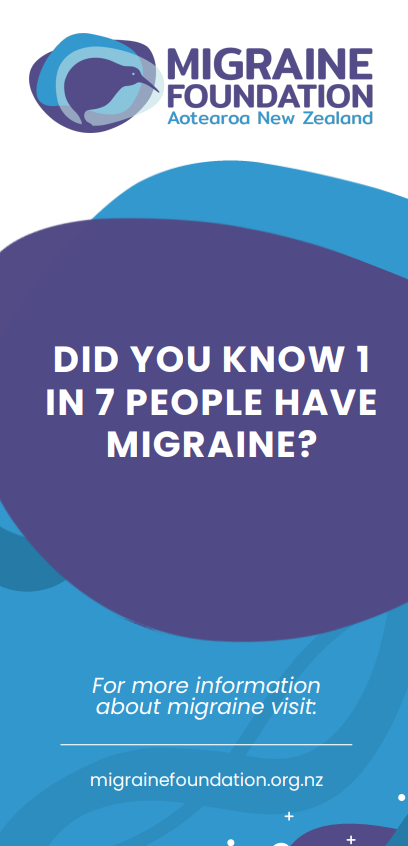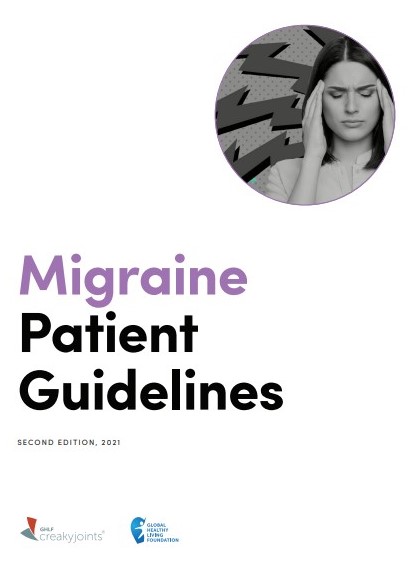Migraine disease | Māhunga ānini
Also known as headache disorder
Key points about migraine disease
- Migraine disease (māhunga ānini) is a debilitating condition causing severe headaches, usually on one side of your head.
- Symptoms include pain, sensitivity to light and noise, nausea and vomiting. Some people have migraine aura beforehand with vision problems, dizziness or pins and needles.
- About 1 in 7 people have migraine disease – more women than men. It usually first occurs between 10 and 30 years of age, and can become more or less severe over time.
- If you are over 50 and a severe headache occurs for the first time, see your healthcare provider.
- Treatment includes pain relief, migraine-specific therapies and lifestyle changes.

A migraine attack can have distinct phases.

Image credit: Adapted from Migraine Foundation, NZ with permission
Phase 1 – prodome
Some people can feel early warning signs that tell them a migraine attack might be coming soon. These warning signs, that can occur a few hours to a few days before the headache starts, are called prodromal symptoms. About 8 in 10 people get prodromal symptoms.
Examples of prodromal symptoms include:
- feeling tired, fatigue
- repeated yawning
- restlessness or irritability
- anxiety
- food cravings, feeling hungry or thirsty
- difficulty concentrating
- dizziness
- sensitivity to light or sound
- neck pain.
Phase 2 – aura
Just before the headache starts you may have changes in 1 or more of your senses of sight, smell, hearing and touch. These changes are part of the "aura" phase. Only about 1 in 4 people with migraine experience aura, so if you've never had these symptoms it doesn't mean you don't have migraine.
Examples of aura symptoms are:
- problems with vision (seeing zig-zag lines, flashing lights or spots in your vision)
- hearing loss or a ringing sound in your ears
- feelings of tingling or numbness in your body.
Phase 3 – headache
When the headache starts, it's a strong pain, usually on one side of your head. You may feel sick or vomit (be sick), get tingling around your mouth, have trouble talking or feel dizzy or weak.
Phase 4 – Postdrome
The final phase of a migraine attack is the postdromal (or 'hangover') phase. This is when your headache has resolved but other symptoms (eg, fatigue, nausea and difficulty thinking) continue for a day or more.
Read more about the phases of a migraine attack(external link).
Migraine is diagnosed, and separated out from other forms of headache, based on your medical history and clinical criteria. The following symptoms are common to migraine attacks:
- Moderate to severe pain on one side of your head, usually pulsating and lasting 4 to 72 hours.
- Strong sensitivity to light and noise.
- Nausea (feeling sick) or vomiting (being sick).
- Aura.
- Routine physical activity may make your symptoms worse.
A migraine attack can be frightening and you may feel overwhelmed, but it's not a sign of a stroke or a tumour. Your healthcare provider will reassure you of this and do additional tests if they're concerned your headaches may have another cause.
There are different types of migraine (eg, vestibular migraine) and there are also other headache disorders including tension-type headache and cluster headache that have different symptoms.
Migraine can't be cured but you can relieve symptoms during an attack and prevent further attacks (see below). Migraine varies between people and so does the treatment. Some things are commonly known to trigger migraine attacks in some people. Managing these triggers can reduce how often and how severe your migraine attacks are.
Medicines
Medicines for the treatment of migraine are aimed at stopping symptoms and preventing future attacks. The type of medicine you need depends on many things – including how often, severe and disabling your migraine attacks are. It may take some time to work out the best treatment for you. You may need to try different types or combinations of medicines before you find the most effective ones.
Medicines to prevent migraine attacks are taken regularly to reduce how often and how severe your migraine attacks are.
Medicines to treat attacks as they occur are taken during a migraine attack to help stop symptoms that have already begun. These include:
- pain-relieving medicines and triptans (migraine-specific medicines)
- medicines for nausea (feeling sick) or vomiting (being sick).
These medicines are most effective when taken early in an attack, before severe pain and nausea have set in. Opioids (eg, codeine or tramadol) are not recommended for treating migraine attacks.
Read more about medicines for migraine.
Medication-overuse headache
Medication-overuse headache (also known as medication adaptation headache or rebound headache) can occur if you use pain relief medicines or triptans to treat headaches and migraine attacks over a long time (regularly for 3 months or more). If you're taking these medicines and you're having headaches more than 15 days per month then you may be experiencing medication-overuse headache.
Read more about medication-overuse headache and how to avoid it.
Here are some simple things to try that may ease your symptoms.
- Lie in a quiet, cool, dark room.
- Avoid moving around too much.
- Put a cold flannel or gel pack on your neck or forehead. Some people find that heat helps instead, or wrapping your head.
- Avoid drinking tea, coffee or orange juice. A ginger drink may help with nausea.
- Try to relax by listening to music or through meditation.
- Don't read or drive, and avoid screen-time.
- Sleep through the attack.
- A transcutaneous electrical nerve stimulation (TENS) device developed for migraine treatment, placed on your forehead, can help with pain.
Apps reviewed by Healthify
You may find it useful to look at some Migraine and headache apps and Pain management apps.
The exact cause of migraine disease is still being studied but it's partly genetic and partly caused by environmental and other factors – some are unknown. People with migraine often find that others in their wider family also have the condition.
Video: What causes migraine disease?
This video may take a few moments to load.
Many different things can trigger a migraine attack. Learning what triggers your migraine attacks and finding ways to avoid or reduce these triggers can help in managing migraine disease.
Keeping a diary of when you have a migraine episode and what may have started it may help you work out your triggers. Triggers often relate to changes in the environment or your body, and a combination of factors might make you more or less sensitive to a trigger at different times.
Triggers
Triggers can include 1 or more of the following:
- stress, anxiety or depression
- tiredness
- hunger (missing meals)
- not drinking enough water (dehydration)
- exercise (especially heavy exercise when unfit)
- hormonal changes in women (taking the contraceptive pill, having your period, going through menopause)
- excess caffeine from coffee, tea, caffeinated energy drinks, or changes in caffeine consumption
- alcohol
- some foods (if an attack occurs within 6 hours of eating that food but you don't get attacks when you don't eat that food)
- changes in sleep patterns (lack of sleep or oversleeping)
- relaxation following stress, eg, during weekends or holidays
- long distance travel
- changes in the weather or temperature
- strong smells, loud noise, bright or flickering lights
- some medicines used for other conditions (eg, some angina medicines, the contraceptive pill, hormone therapy)
- overuse of pain-relieving medicines can cause medication overuse headache.
There is little evidence that specific foods (eg, chocolate) actually trigger a migraine attack. However, research shows that food cravings can occur in the prodromal stage of a migraine attack (when the attack has already begun but before the headache starts) which could explain the association between some foods and migraine attacks.
Doctors recommend focusing on positive ways to prevent attacks, including lifestyle changes and other approaches. Focusing too much on trigger avoidance can lead to anxiety and self-blame.
You can watch a video on migraine causes and triggers on this Migraine Again(external link) page.
Women and migraine disease
Female hormone fluctuations, having your period (menstruation), oral contraceptives, menopause and pregnancy may affect migraine.
- Migraine attacks often happen around the time of your period (menstrual migraine), within the 2 days before and 3 days after bleeding has started.
- Many women find migraine disappears during pregnancy.
- Oral contraceptives containing oestrogen may change migraine frequency.
- Some women get migraine during perimenopause (when your body is preparing for and experiencing menopause) or their migraine attacks get worse.
- Many women find that migraine attacks reduce in frequency or severity after menopause – especially if they've had menstrual migraine.
Non-migraine headache is also a common feature of pre-menstrual syndrome.
Not all migraine attacks have an obvious trigger, but sudden changes in daily routine can be a trigger. This includes a missed meal, a late night or doing more strenuous exercise than you normally do.
To reduce your chance of having a migraine attack you may find it helpful to make the following lifestyle changes:
- Have regular meals.
- Drink enough water/fluid to stay hydrated.
- Do relaxation and exercises for stress (eg, meditation and yoga).
- Aim for a regular sleep pattern and make sure you have enough sleep (but avoid long sleep-ins).
- Don't do sudden strenuous exercise. Regular exercise is beneficial but build up slowly when starting or increasing an exercise routine.
- Limit caffeine intake, eg, to no more than 2 cups of coffee a day.
Addressing other conditions that may be causing your migraine attacks is also important. These include stress, anxiety, depression, hormonal changes and head or neck trauma. If these are problems, talk to your healthcare provider. They may be able to help you work out how to manage these things.
Cognitive behavioural therapy (CBT), biofeedback, coping strategies and relaxation training are helpful for many people with migraine, especially if attacks are associated with anxiety or stress.
Supplements that may be useful for prevention are magnesium, riboflavin (vitamin B2) and coenzyme Q10. Ask your healthcare provider about supplement use and possible interactions with other medicines.
Preventive medicines
Preventive medicines are taken regularly to prevent migraine attacks from happening. They're not used to treat a migraine attack. Medicines to prevent migraine attacks are an option if you:
- have at least 2 migraine attacks a month
- have significant disability despite taking suitable treatment for migraine attacks
- can't take suitable treatment for migraine attacks.
Preventive medicines aim to reduce how long and severe your migraine attacks are and how often you get them. They can help to reduce disruption to your daily activities that happens with migraine attacks, and reduce overuse of pain relief medicines and triptans. They must be taken as prescribed to work well. They may take a few weeks to start working. Read more about preventive medicines for migraine.
It's likely that you'll keep having migraine attacks and these may become more frequent and can be very disruptive and debilitating. However you may find your migraine attacks become less frequent over time.
For videos of people sharing their personal stories, visit Migraine Again(external link).
Migraine Foundation Aotearoa NZ(external link) New Zealand's only not-for-profit supporting people living with migraine in Aotearoa.
Migraine Foundation Aotearoa NZ support group(external link) A Facebook support group for people living in New Zealand to connect with others.
Migraine NZ Chat Group(external link) Facebook support group
The following links provide further information about migraine disorder. Be aware that websites from other countries may have information that differs from New Zealand recommendations.
Migraine Foundation Aotearoa New Zealand(external link)
Migraine(external link) Neurological Foundation, NZ
Headache types(external link) Coalition for Migraine and Headache Patients (CHAMP), Australia, 2018/19
A patient's guide to migraine(external link) Dr Jon Simcock, Medical Adviser, Neurological Foundation, NZ
Living with migraine(external link) The Migraine Trust, UK
Range of topics(external link) American Migraine Foundation, US
Shades for migraine(external link) A global awareness campaign that asks everyone to wear a pair of sunglasses on 21 June to show their support for the 1 billion people living with migraine disease worldwide.
Migraine World Summit(external link) Discover what dozens of world-leading migraine experts, doctors, and specialists really do for migraine and headache.
Brochures
Treating migraine headaches – some drugs should be rarely used(external link) Choosing Wisely, NZ
Migraine patient guide [PDF, 3.6 MB] Global Healthy Living Foundation, US
Migraine brochure(external link) Migraine Foundation Aotearoa New Zealand
Treatment of acute migraine attacks(external link) Migration Foundation Aotearoa New Zealand
Apps/tools
Migraine and headache apps
Pain management apps
References
- Cafergot tablets to be prohibited 1 May 2020(external link) Medsafe, NZ, 2019
- The role of triptans in the treatment of migraine in adults(external link) BPAC, NZ, 2014
- Medication-overuse headache(external link) BPAC, NZ, 2008
- Headache types(external link) Coalition for Migraine and Headache Patients (CHAMP), Australia, 2018/19
- Steiner TJ, Stovner LJ. Global epidemiology of migraine and its implications for public health and health policy(external link) Nat Rev Neurol. 2023; 19:109–117
- Grangeon L, Lange KS, Waliszewska-Prosół M, et al. Genetics of migraine – where are we now?(external link) J Headache Pain 2023;24(1):12
- Kuruvilla D, Wells RE. Evidence based integrative treatments for headache(external link) Headache 2019;59(6):971-972
Brochures

Treatment of acute migraine attacks Migraine Foundation Aotearoa New Zealand, 2023

Migraine Foundation Aotearoa New Zealand, 2022

Global Healthy Living Foundation, US, 2021
Credits: Healthify editorial team. Healthify is brought to you by Health Navigator Charitable Trust.
Reviewed by: Dr Fiona Imlach, Migraine Foundation Aotearoa New Zealand; Professor Debbie Hay, Department of Pharmacology & Toxicology, University of Otago
Last reviewed:





